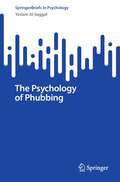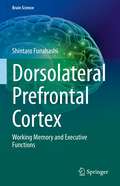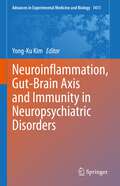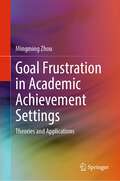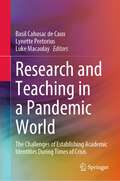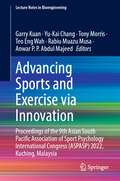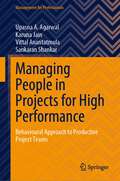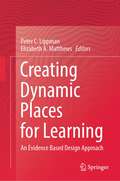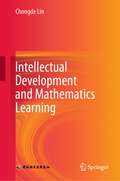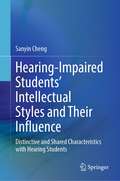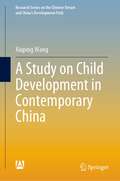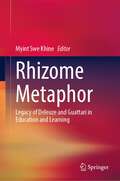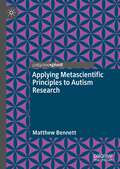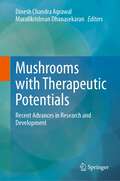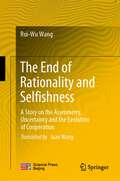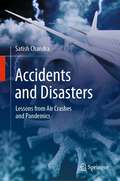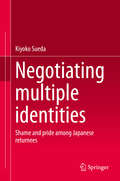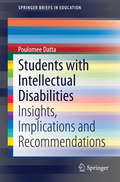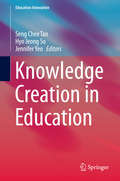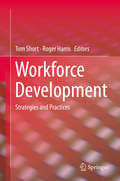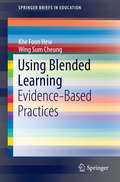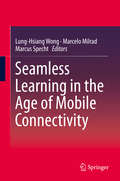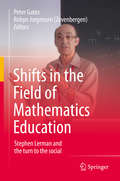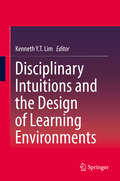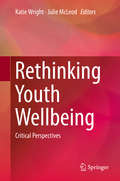- Table View
- List View
The Psychology of Phubbing (SpringerBriefs in Psychology)
by Yeslam Al-SaggafThis book focuses on the effects of phubbing by parents on their children, partners on their partners, bosses on their employees, friends on their friends, and family members on other family members. Having synthesised the findings from published research about the specific effects on these phubbed individuals in important relationships, the book then presents an exposition of the psychological predictors of phubbing (the triggers), followed by a broader account of the psychological effects of phubbing behaviour. The final chapter looks at the role of social norms in explaining the act of phubbing beyond the individual predictors that trigger the behaviour as it tries to draw a connection between phubbing and social theory.
Dorsolateral Prefrontal Cortex: Working Memory and Executive Functions (Brain Science)
by Shintaro FunahashiThe prefrontal cortex is known to play important roles for performing a variety of higher cognitive functions. Among regions of the prefrontal cortex, the dorsolateral prefrontal cortex plays the most important roles for these functions. This book focuses on functions of the dorsolateral prefrontal cortex, summarizes research results obtained mainly by non-human primate studies, and describes neural mechanisms of executive functions that the dorsolateral prefrontal cortex participates. First, to understand the feature of the dorsolateral prefrontal cortex and how its function has been understood, anatomical and functional features of the dorsolateral prefrontal cortex and historical overview of prefrontal functions are described. To understand functions of the prefrontal cortex and neural mechanisms of executive functions, working memory is an important concept and sustained activation during the memory period of working memory tasks is known as a neural mechanism of working memory. Therefore, this book describes features of sustained memory-related activity based on neurophysiological results obtained in the prefrontal cortex and how memory-related activity contributes to executive functions including control of attention, inhibitory control, task management, and planning. And further, this book describes how the dorsolateral prefrontal cortex contributes to neural mechanisms for sensory and motor processing, memory control in multi-task performance, decision-making, metacognition, and top-down control. Thus, this book provides important information regarding neural mechanisms of dorsolateral prefrontal functions to neuroscientists and helps to plan further investigation to understand prefrontal functions in primates and human subjects.
Neuroinflammation, Gut-Brain Axis and Immunity in Neuropsychiatric Disorders (Advances in Experimental Medicine and Biology #1411)
by Yong-Ku KimThis book reviews the relationship between cytokines, glia, and neurons in the pathophysiology of neuropsychiatric disorders and examines the mechanisms of action of the drugs used for the treatment of these disorders. Increasing evidence has suggested that glia perform important roles in various brain functions, but much remains to be learned about these crucial cells and their interplay with neurons. In addition, a better understanding of the interaction between inflammatory mediators, such as cytokines, and the activated immune response will be of critical importance for the development of new therapeutic strategies. These key areas are the focus of this book, which documents the latest research findings in the field. Evidence is provided for the role of inflammation-induced toxic metabolites from the tryptophan pathway in a wide range of neuropsychiatric disorders, including depression, schizophrenia, and Alzheimer's disease. In presenting state of the art knowledge on the interactions between cytokines, glia, and neurons, the book will help to pave the way for the development of novel targets for the prevention and treatment of neuropsychiatric disorders.
Goal Frustration in Academic Achievement Settings: Theories and Applications
by Mingming ZhouThis book provides in-depth description, explanation, and discussion of goal frustration. It brings together a repertoire of perspectives and strategies that educators and scholars from diverse educational contexts have conceptualized and/or implemented in order to monitor, control, or overcome the occurrence of frustration. This book describes the new technologies can be applied in the conceptualization and operationalization of goal frustration. It also discusses the strategies and pedagogies we can use to cope with this emotion. This book offers evidence-based reports of goal frustration as well as data-driven approaches by presenting both theoretical account and empirical evidence that are grounded in educational and psychological research. This work will appeal to a wider readership from practitioners, parents, to educational researchers.
Research and Teaching in a Pandemic World: The Challenges of Establishing Academic Identities During Times of Crisis
by Basil Cahusac de Caux Lynette Pretorius Luke MacaulayThis book adopts collaborative autoethnography as its methodology, and presents the collective witnessing of experiences of the COVID-19 pandemic within the higher education sector. Through the presentation of staff and student experiences and what was learnt from them, the authors examine the global phenomenon that is the COVID-19 pandemic through the purposeful exploration of their own experiences. This book presents an overall argument about the state of higher education in the middle of the pandemic and highlights academic issues and region-specific challenges. The reflections presented in this book offer insights for other staff and students, as well as academic policy-makers, regarding the pandemic experiences of those within academia. It also offers practical suggestions as to how we as a global community can move forward post-pandemic.
Advancing Sports and Exercise via Innovation: Proceedings of the 9th Asian South Pacific Association of Sport Psychology International Congress (ASPASP) 2022, Kuching, Malaysia (Lecture Notes in Bioengineering)
by Garry Kuan Yu-Kai Chang Tony Morris Teo Eng Wah Rabiu Muazu Musa Anwar P. P. Abdul MajeedThis book presents the proceedings of the 9th Asian South Pacific Association of Sport Psychology International Congress (ASPASP) 2022, Kuching, Malaysia, which entails the different sporting innovation themes, namely, Applied Sport and Social Psychology, Health and Exercise, Motor Control and Learning, Counselling and Clinical Psychology, Biomechanics, Data Mining and Machine Learning in Sports amongst others. It presents the state-of-the-art technological advancements towards the aforesaid themes and provides a platform to shape the future direction of sport science, specifically in the field sports and exercise psychology.
Managing People in Projects for High Performance: Behavioural Approach to Productive Project Teams (Management for Professionals)
by Upasna A. Agarwal Karuna Jain Vittal Anantatmula Sankaran ShankarThis book examines practically useful management and people skills, and looks at competencies from the micro, meso, and macro- lens. At the micro- level, the book examines a range of competencies needed for managing oneself and others in a project environment, such as personality style, cognitive skills, communication skills, and emotional intelligence. The book will also includes discussion on strategies for managing emotions of self and others effectively. At the meso- level, the book discusses basic structure, characteristics, and importance of different types of teams such as virtual teams, project teams, domain specific teams, and heavy-weight teams in organizations to enhance productivity and delegate accountability. It also explores team processes, including structure, culture, supporting systems, performance and incentive systems, and their impact on team productivity. In addition, the book includes a discourse on skills to manage a multi-generational workforce (a combination of baby boomers, X and Y generation), a challenge faced by project managers in current scenario. Finally, at the macro- level, the book captures the role of culture in a project context; emerging leadership styles in projects, maintaining relationship with internal and external stakeholders; role of power, politics and influence in relationship building (social networks and social capital); and managing conflicts and negotiations. The book presents ethical considerations in managing projects; relationship between projects and sustainability; societal responsibilities of projects; advantages and disadvantages of forms of control in projects (behaviour and outcome control). It is positioned primarily for practitioners although it is a relevant and useful resource and reference for academics and students of project management and management studies courses.
Creating Dynamic Places for Learning: An Evidence Based Design Approach
by Peter C. Lippman Elizabeth A. MatthewsThis book showcases how an evidence-based design approach can be utilized in the planning of learning environments, by acknowledging the interconnectedness of research, practice, and theory as core considerations in the design of learning environments. Toward this end, this volume explores a multi-disciplinary perspective that draws upon modern learning theories, and empirical research from the fields of environmental psychology education, and architectural practice. By presenting this information in an accessible manner, it enables researchers, educators and designers to take actionable steps needed to re-imagine their settings and create dynamic places for learning.
Intellectual Development and Mathematics Learning
by Chongde LinThis book introduces the outcomes of author’s 40 years of research, especially the theory of “the Triangular Pyramid Structure of Thinking” that he independently proposed, and the application of his development theory in the field of mathematics education. The book firstly explains the substantial character of intelligence, the development law of intelligence, and the relationship between intelligence development and creativity cultivation. Secondly, it discusses the structure of mathematical thinking of children and adolescents from 0 to 18 years old, and the methods of developing students’ thinking ability and the quality of intelligence through arithmetic learning. In the end, this book also demonstrates the characteristics of the development of mathematical thinking ability of children at age 0-6, elementary school students, and secondary school students, and the related latest research in this field. Based on the theory of “the Triangular Pyramid Structure of Thinking”, a number of examples are given to illustrate how the theory of intelligence development can be used in mathematics teaching to promote the development of students’ thinking abilities and to improve the quality of teaching.This book covers various areas including psychology, mathematics, and education. It has a great reference value for scholars in the field of psychology to study the theory of intelligence and the structure of thinking, providing guidance for parents and mathematics teachers to promote children’s quality of intelligence and mathematical thinking abilities, and to enhance their mathematics learning effects. In addition, it provides examples for psychological research to serve specific subject teaching in elementary and secondary schools.
Hearing-Impaired Students’ Intellectual Styles and Their Influence: Distinctive and Shared Characteristics with Hearing Students
by Sanyin ChengThis book is the first on the implications of intellectual styles for higher education of students with hearing impairment. It provides a systematic delineation for intellectual styles of students with hearing impairment in comparison with students without hearing impairment. It takes an initial step to present the analysis concerning the mediating role of intellectual styles in the relationships between personal factors and student developmental outcomes.
A Study on Child Development in Contemporary China (Research Series on the Chinese Dream and China’s Development Path)
by Xiuping WangThis book is devoted to the description and analysis of child population, rights to survival and development, culture and policies that Chinese government made in contemporary China. The book pursues three major objectives: firstly, to objectively describe child development in contemporary China ; secondly, to analyze characteristics of child development in contemporary China; and thirdly, to review all types of policies Chinese government has made on children survival, protection and development, which played important roles on promoting child development.
Rhizome Metaphor: Legacy of Deleuze and Guattari in Education and Learning
by Myint Swe KhineThis comprehensive volume highlights the paradigm shift, creative approaches, and theoretical and practical aspects of rhizomatic learning. The great French theorists Deleuze and Guattari introduced the concept of the rhizome to allow educators to explore the educative process with the rhizomatic lens. The chapters cover digital pedagogies, the conceptual framework of rhizome and nomadic pedagogy in 21st-century education. It creates rhizomatic learning environments and rhizome metaphors to illuminate learning and teacher professional development. It covers an extensive range of issues and challenges related to teaching and learning in the techno centric education systems. It presents an up-to-date and comprehensive analysis of rhizomatic learning approaches in various disciplines. It examines the following key questions: What is the conception of rhizomatic learning and nomadic pedagogy? In which ways can rhizomatic learning transform teaching methods in the digital era? How can educators implement a rhizomatic learning approach in practice? What is the connection between the rhizomatic process and divergent thinking in socially mediated and technology-driven learning environments? Combining theory and practice, this book is essential reading for educational policymakers, teacher educators, university faculty, researchers, instructional designers, learning technologists, teachers, and undergraduate and graduate students worldwide.
Applying Metascientific Principles to Autism Research
by Matthew BennettThis book presents several metascientific strategies and explains how they can be used to improve research about the autism spectrum. It begins with an introduction to the field of metascience and the benefits that it brings to academic disciplines and society. It then outlines recommendations that researchers can adopt so that they do not incorporate specious autism research from predatory publishers into their research activities. An introduction to reproducibility and strategies that can improve the reproducibility of autism research are then outlined. This is followed by chapters about improving the peer review process and reducing the prospect of questionable research practices from occurring. This book concludes with a chapter about strategies that researchers can use to improve the participation of autistics in research. Such knowledge will equip academics, regardless of their experience, with the skills and expertise they need to produce high-quality and inclusive research about the autism spectrum.
Mushrooms with Therapeutic Potentials: Recent Advances in Research and Development
by Dinesh Chandra Agrawal Muralikrishnan DhanasekaranThe book presents new and novel perceptions about ailments alleviating the effects of several mushroom species. Also, the book highlights the curative role of medicinal mushrooms on some peripheral and central diseases. Various chapters in the book (primarily reviews) have been dedicated to providing the therapeutic efficacy of mushrooms against respiratory illnesses, gut microbiota, COVID-19, dementia, epilepsy, mental ailments, cancers, cardiovascular, kidney-related diseases, and other common pathologies. Thus, medicinal mushrooms are current and future consumable healthcare products that usually exhibit nourishing properties and possess prophylactic and therapeutic values with minimal adverse effects and contraindications. The book focuses on Sustainable Development Goal (SDG 3) to promote healthy lives and well-being for all. Medical, pharmacy, nursing, and CAM (complementary and alternative medicine) students, practitioners, scholars, researchers, other healthcare professionals, and general readers are this book’s potential audience. The book can be adopted as a textbook for undergraduate and graduate courses so that the therapeutic potential of mushrooms can reach a wider audience. This book strives to create a new resource for the future use of medicinal mushrooms in various disorders.
The End of Rationality and Selfishness: A Story on the Asymmetry, Uncertainty and the Evolution of Cooperation
by Rui-Wu WangThis book reviews the antinomy of rationality and selfishness raised from egoism, though rationality and selfishness are understood as basic evolutionary dynamics of humans and other organisms in both classical economics and evolutionary biology. Based on the research and a comparison with human’s social cooperative behavior, the author presents his belief that the social cooperative system, in its essence, cooperation and conflict are of uncertain stochasticity resulting from their intrinsic asymmetric interaction between cooperative partners. The book then discusses limitations of Newton’s methodology of monism in both biology and social science. The understanding of the asymmetric and uncertain characteristics found in cooperation system needs perspective of quantum physics of pluralism. At the end of the book, the author undertakes a review of consistency of Newtonian and monism philosophy and the links between quantum physics and pluralism philosophy.
Accidents and Disasters: Lessons from Air Crashes and Pandemics
by Satish ChandraThis book deals with the contemporary subject of perception of risk and its influence on accidents and disasters. The contents examine the conventional viewpoints on human errors, incubation of errors, complexity and organisational deviance as a cause for accidents. Work of Mary Douglas with regard to risk, Charles Perrow's work on the normal accident theory and Diane Vaughan's theory on normalisation of deviance are examined from a fresh perspective in this book. It also discusses prominent accidents in aviation, space, nuclear energy, automotive and healthcare, using the pandemic and Boeing 737 Max as a backdrop to study accidents and disasters. It further explores the background and similarities to these events and addresses the core issues such as the state of regulation, the worldview of the sociologists, and proposes that mental models of complex systems, avarice and risk for gain as other possibilities for accidents. Using the concept of nudge in behavioural economics and the Elinor Ostrom’s viewpoint on regulating for common good, it suggests a way forward through the High Reliability Organisation Theory (HRO) leading to enhanced risk perception. The book will be of interest to those who would like to understand the need to incorporate risk perception into regulation, engineers and scientists, professionals and policy makers working in the areas of disaster and risk management, technology areas like aviation, nuclear plants, space and healthcare, students of the sociology of risk and of course the general reader.
Negotiating multiple identities: Shame and pride among Japanese returnees
by Kiyoko SuedaThis book uses a post-modern approach to explore how Japanese returnee students (kikokushijo) and former returnees who work in Japanese industry, negotiate multiple identities. Methodological triangulation is used to study inner perception of face, emotional state and the dynamics of negotiating multiple-layering of identities. The work considers the relationship between face and identities, and the function of the affective aspects of face, shame and pride in identity negotiation.Readers will discover how Japanese returnees deal with shame and pride in face-threatening or face-promoting situations that affect their identity negotiation. Many such returnees stayed abroad because of their parents’ jobs and the author explores variations among them, in terms of how they identify with their identity as a returnee. We discover how there are multiple levels of identities instead of ‘identity’ as a singular.Two phases of research, carried out across ten years and involving some participants in both phases, are explored in this work. Although the participants in the research are Japanese returnees, the findings drawn from the study have implications for others who spend an extensive period of time overseas, who migrate from one place to another or who have multiple cultural backgrounds.The book incorporates ideas from Western and Eastern literature on intercultural communication, sociology and social psychology and it blends both micro and macro analysis.This book is recommended for scholars, educators, students and practitioners who seek to understand better how people negotiate their multiple identities in this globalising world.
Students with Intellectual Disabilities: Insights, Implications and Recommendations (SpringerBriefs in Education)
by Poulomee DattaThis book investigates the self-concept of the students with intellectual disabilities who were placed in specialist and mainstream educational settings in South Australia. It gains insights into what students with intellectual disabilities felt about themselves and their achievements across the different dimensions of self-concept. It is divided into two stages of execution. In Stage 1, the Tennessee Self-Concept questionnaire was administered to students with intellectual disabilities. In Stage 2, interviews were conducted with students with intellectual disabilities, their parents and teachers. These data reflected a range of viewpoints from which to examine the research questions. These findings have implications for teachers, special educators, policy makers and a range of professionals in the education and special education sector in enabling greater understanding of the problems experienced by these students and pointing to modifications and improvements in the services for these students.
Knowledge Creation in Education (Education Innovation Series)
by Seng Chee Tan Hyo Jeong So Jennifer YeoThis book arises from research conducted through Singapore’s National Institute of Education on such topics as integrating knowledge building pedagogies into Singaporean classrooms, with both students and teachers across school levels, from primary schools to high schools. Additionally, international scholars contribute research on theories of knowledge creation, methodological foundations of research on knowledge creation, knowledge creation pedagogies in classrooms and knowledge creation work involving educators. The book is organized in two sections. Section A focuses on theoretical, technological and methodological issues, where sources of justification for claims are predominantly theories and extant literature, although empirical evidence is used extensively in one chapter. Section B reports knowledge creation practices in schools, with teachers, students or both; the key sources of justification for claims are predominantly empirical evidence and narratives of experience The editor asserts that schools should focus on developing students’ capacity and disposition in knowledge creation work; at the same time, leaders and teachers alike should continue to develop their professional knowledge as a community. In the knowledge building vernacular, the chapters are knowledge artifacts – artifacts that not only document the findings of the editors and authors, but that also mediate future advancement in this area of research work. The ultimate aim of the book is to inspire new ideas, and to illuminate the path for researchers of similar interest in knowledge creation in education.
Workforce Development: Strategies and Practices
by Tom Short Roger HarrisThis book is the second in a series of two volumes that reviews a broad range of strategies and practices undertaken as workplace development activities in a post-global financial crisis period when organisational volatility and survival were foremost in the minds of leaders. Drawing mainly from a wide range of major research projects conducted Australia and with some contributions from international authors, this second book is a compilation of contemporary themes and applications that were developed from individual research projects. During the global financial crisis, the Australian economy out-performed many other developed countries, but it was not immune from international pressures such as global competition, market fluctuations and an increasingly mobile workforce. These issues are reflected in many of the chapters and the combined work will inform readers about the major workforce development challenges facing public and private sector organisations. The book blends relevant literature with rich empirical evidence gathered from large and small organisations and includes application tools developed by researchers who are experts in their field. This book will be of scholarly interest to a broad audience of academics, industry leaders, human resource practitioners and students in adult education, business, psychology and social science disciplines. Moreover, the book will be of interest to education and training professionals, management consultants, and more generally, people who follow the evolution of work and its impact on contemporary society.
Using Blended Learning: Evidence-Based Practices (SpringerBriefs in Education)
by Khe Foon Hew Wing Sum CheungThis book discusses evidence-based practices related to the use of blended learning in both K-12 and higher education settings. Specifically, this book features evidence-based practices in relation to the following five learning goals: (a) Fostering students’ attitude change toward country, (b) Helping students’ solve ill-structured design task problems, (c) Improving students’ critical thinking in assessing sources of information, (d) Improving students’ narrative and argumentative writing abilities and (e) Enhancing students’ knowledge retention and understanding. To achieve this aim, the authors draw upon their own research studies as well as some other relevant studies to reveal the pedagogical approaches, the specific instructional/learning activities, the technologies utilized and the overall framework for developing blended learning experiences.
Seamless Learning in the Age of Mobile Connectivity
by Lung-Hsiang Wong Marcelo Milrad Marcus SpechtThe book departs from the approach of related titles by focusing on describing and reflecting upon the notion of seamless learning with regard to salient characteristics of learner mobility and bridging of learning experiences across learning spaces. It is the first such work that is solely dedicated to research on and the practice of seamless learning, uniquely combining interpretations, visions, and past research on and practices in seamless learning from diversified perspectives. The book also strikes a good balance between theoretical and practical perspectivess, going beyond a collection of reports on specific research projects. Instead of thick descriptions of research processes and findings, readers will find significant insights and food for thought intended to inspire further advances in the research on and practice of seamless learning.
Shifts in the Field of Mathematics Education: Stephen Lerman and the turn to the social
by Peter Gates Robyn JorgensenProfessor Stephen Lerman has been a leader in the field of mathematics education for thirty years. His work is extensive, making many significant contributions to a number of key areas of research. Stephen retired from South Bank University in 2012, where he had worked for over 20 years, though he continues to work at Loughborough University. In this book several of his long standing colleagues and collaborators reflect on his contribution to mathematics education, and in so doing illustrate how some of Steve’s ideas and interventions have resulted in significant shifts in the domain.
Disciplinary Intuitions and the Design of Learning Environments
by Kenneth Y. T. LimAs children, we would have spilt glasses of milk, dropped things, and broken things. As children, therefore, we would have developed intuitions about how the world ‘works’, but we would not necessarily have been able to explain these ‘workings’. It would only have been till we entered formal schooling that we would have learned codifications of canon within each respective discipline, and consequently how to articulate the canon to explain the intuition.The preceding example was from the natural sciences, but one could just have easily taken an example from, say, the environmental sciences or from the social sciences. Indeed, much of this book does just that, as it seeks to chart the territory of a new theory of learning around Disciplinary Intuitions.Many of the chapters within draw frequent and explicit linkages to curriculum design, from the premise of the need to go beyond addressing the conceptions of learners, to seeking to understand the substrate upon which these conceptions are founded. The argument is made that this substrate comprises the particular set of lived experiences of each learner, and how – because these lived experiences are as tacit as they are diverse – designing curriculum around misconceptions and preconceptions alone would not lead to enduring understanding from first principles. From this perspective, Disciplinary Intuitions constitute an exciting field at the nexus of learning theories and curriculum design.
Rethinking Youth Wellbeing: Critical Perspectives
by Katie Wright Julie McLeodThis volume offers a critical rethinking of the construct of youth wellbeing, stepping back from taken-for-granted and psychologically inflected understandings. Wellbeing has become a catchphrase in educational, health and social care policies internationally, informing a range of school programs and social interventions and increasingly shaping everyday understandings of young people. Drawing on research by established and emerging scholars in Australia, Singapore and the UK, the book critically examines the myriad effects of dominant discourses of wellbeing on the one hand, and the social and cultural dimensions of wellbeing on the other. From diverse methodological and theoretical perspectives, it explores how notions of wellbeing have been mobilized across time and space, in and out of school contexts, and the different inflections and effects of wellbeing discourses are having in education, transnationally and comparatively. The book offers researchers as well as practitioners new perspectives on current approaches to student wellbeing in schools and novel ways of thinking about the wellbeing of young people beyond educational settings.
